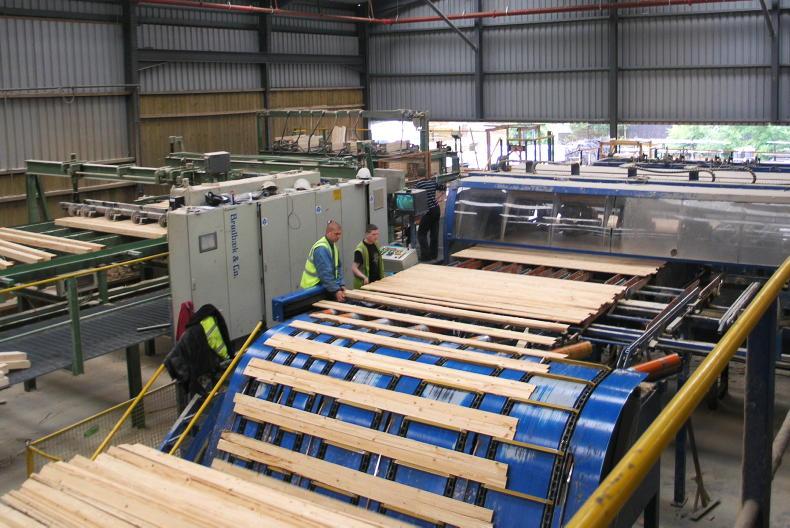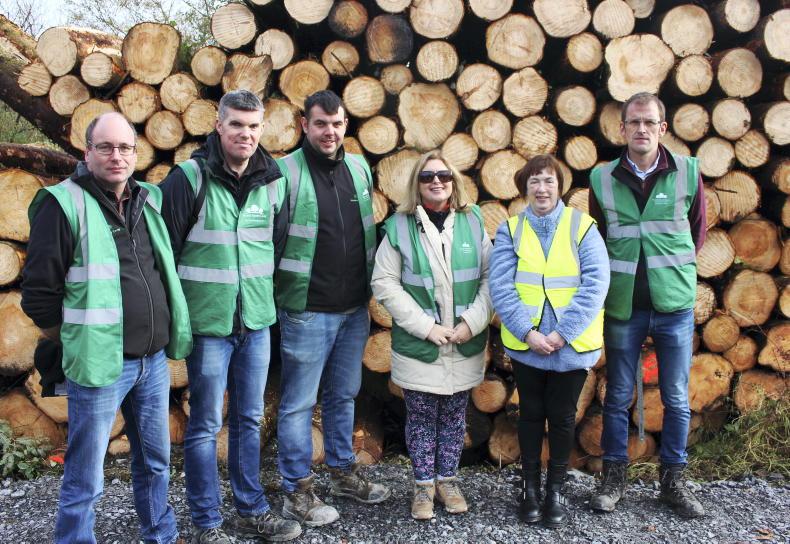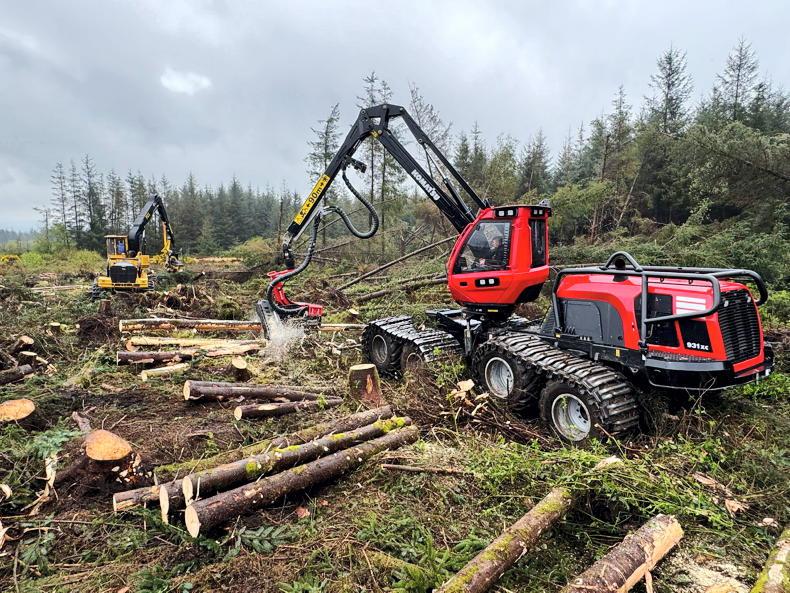At a recent Coillte standing timber sales auction, a large sawlog lot made €126/m3.
That a price of this magnitude was not the highest recorded so far this year illustrates the unprecedented record high prices now being achieved for Irish timber.
For the first three quarters last year, prices rarely exceeded €70/m3, which were up 30% for the same period in 2019.
There was one major difference in bidding during the recent Coillte electronic auction compared with previous auctions this year. Sawmillers held their nerve and instead of an outright bidding war for scarce logs, prices gradually decreased, first to €121/m3 and closing at €95/m3.
This allows Coillte to retain its pulpwood material
Small sawlog or boxwood was between €82/m3 and €89/m3. Sales of roadside large sawlog timber ranged between €125/m3 and €130/m3. Pulpwood prices are not available from Coillte data as the company has a buyback or retention clause. This allows Coillte to retain its pulpwood material, mainly to supply its two Medite Smartply board mills. Estimated prices for pulpwood or fuelwood range from €35/m3 to €40/m3.
These prices are based on conversations with sawmill and forestry company spokespersons. Asked about the price range for large and small sawlog, a Coillte spokesperson said they were close to prices achieved in recent auctions, but urged caution when making price assumptions.
Coillte and private sales data are made available by quarter, but this is no longer the case
“It should be remembered that these prices are for auction sales, while most of timber sold to mills is by contract or quota,” the spokesperson said. Pressed on the price differential, she added: “Auction prices can be 10% to 15% higher than contract sales.”
Normally, Coillte and private sales data are made available by quarter, but this is no longer the case. Because auctions are few and far between – only three this year because of licence delays – the Coillte spokesperson said the company is reluctant to issue prices but will do so by year end when more data should be available.
Private forest owners rely on price data from the confidential Wood Price Quarterly (WPQ) price survey, conducted by UCD on behalf of the Irish Timber Growers Association (ITGA). “Insufficient data” was the reason cited by a WPQ spokesperson for not releasing prices.
A felling licence is the hottest ticket in Irish forestry right now, as private forest owners are price makers at the thinning or clearfell stages. They should command prices similar to Coillte. For example, a standing clearfell comprising 70% large sawlog and 30% small sawlog and pulpwood should average €85/m3 to €95/m3. This would provide revenue in excess of €30,000/ha, assuming a volume of at least 400m3/ha, based on a stocking rate of close to 1,000 quality trees/ha.
Sweden has increased exports to the US, where record high prices are also being achieved in a market where domestic supply is not able to meet house building demand
Forest owners waiting for felling licence approval by the Department are asking “will these high prices last?” The recent, more sensible bidding in the Coillte auction suggests a levelling off in prices, but they are likely to remain high.
This is not just a trend in Ireland, but throughout Europe and globally. Sweden has increased exports to the US, where record high prices are also being achieved in a market where domestic supply is not able to meet house building demand.
While the US market amounts to little over 5% of Swedish production, it is sizable, as the Swedes harvest 90m m3 annually. The Baltic countries and Germany have also increased exports to the US.
Demand for European timber is also coming from China, as the country’s trade war continues with the US. China is now a growing market for some European countries, especially Finland.
Irish and European sawmillers aren’t complaining about increased log prices, as the finished product is achieving record prices.
Irish sawmills will be in prime position to avail of this increased market share
It is estimated that the recent timber price hike is adding €15,000 to the average house cost in Ireland, according to Mark McAuley of Forest Industries Ireland (FII).
The US National Association of Home Builders estimates that the increased cost of logs – domestic and global – has added approximately $36,000 to the average house price.
Should the New Housing Plan for Ireland achieve its annual target of 33,000 new homes from 2021 to 2030, Irish sawmills will be in prime position to avail of this increased market share. With log supply from private growers forecast to increase from 1.4m m3 at present to 3.3m m3 within five years, there should be sufficient timber available when added to the 2.9m m3 annual Coillte production.
Unfortunately, nobody knows for sure how much of this will reach construction, pallet, fencing, panelboard, energy and other markets due to the ongoing shortfall in felling licences. Without a resolution to the felling licence debacle, timber prices are unlikely to fall anytime soon.
Cautious welcome for new standards for solid wood fuels
The Irish Bioenergy Association (IrBEA) gave a cautious welcome to Minister for the Environment Eamon Ryan’s announcement of “new standards for domestic solid fuels”. The new regulations set a standard for wood moisture levels, ensuring that wood fuel is clean-burning and efficient.
“The introduction of a 25% limit on fuel moisture content, later to be reduced to 20%, is a welcome development for the market,” said Noel Gavigan, technical executive, IrBEA.
“Through the Wood Fuel Quality Assurance (WFQA) scheme, which IrBEA administers, we already have several dozen wood fuel suppliers in the Irish market that produce fuel to the 25% moisture content standard.
“WFQA-certified wood fuels at this low moisture are of great benefit to the customer in terms of efficiency, heat generation and clean burning.”
Any campaign rolled out by the Department should encourage people to move away from open fires and fossil fuels
He was concerned about one aspect of the proposed public awareness campaign, which states: “Ask yourself: do I need to light a fire?”
It suggests using “other cleaner heating sources instead if possible” which “sends a confusing message to the general public”, according to Gavigan.
“Any campaign rolled out by the Department should encourage people to move away from open fires and fossil fuels and use more efficient and renewable heating sources rather than questioning if they should light a fire in the first place,” he said.
“The Department of the Environment should encourage consumers to use eco-design wood-fired appliances as a replacement to open-fired fossil systems.”
Seán Finan, CEO IrBEA, said the success of the proposed solid fuel regulations implementation will ultimately depend on the level of resources dedicated to its enforcement and regular monitoring of compliance.
“This needs to be backed up by an effective campaign which encourages consumers to make the move away from fossil fuel sources to renewable options,” he said.
Department dashboard update
When the Department made a change in the way forestry projects, requiring Appropriate Assessments (AA) under the Habitats Directive, were assessed last July, it was believed licences would slow down for one month.
The legislative change, which was made in accordance with Statutory Instrument (SI) No 293, has resulted in a dramatic reduction of licences lasting two months, as recorded in the Department dashboard.
Fall
After the legislative change, licences fell from 115 per week to 27 per week in July.
The expected return to normality in August didn’t materialise, as licences averaged 41 compared with the weekly target of 120.
The first two weeks in September saw a return to May figures, when 251 licences were issued.
Only 5% of these were for afforestation, which is the lowest percentage of overall licences since the dashboard was initiated to record licence performance in felling, roading and planting.
Private licences with ecology fell to 46 for July and August well down on the 440 target.









SHARING OPTIONS